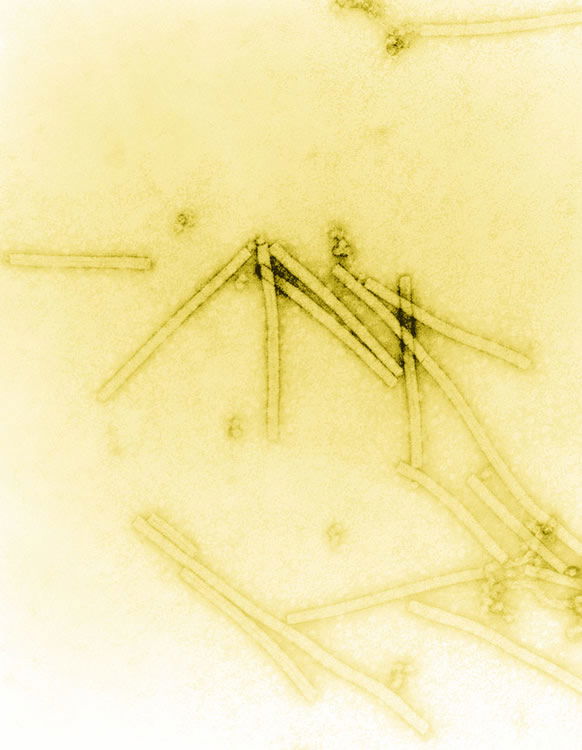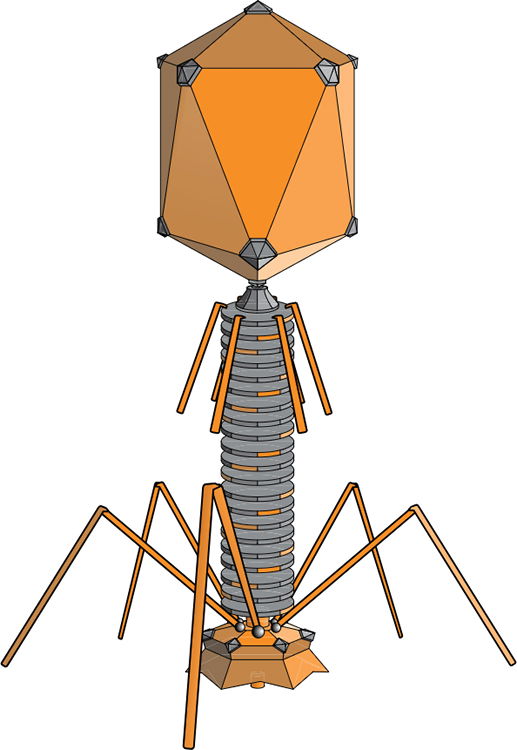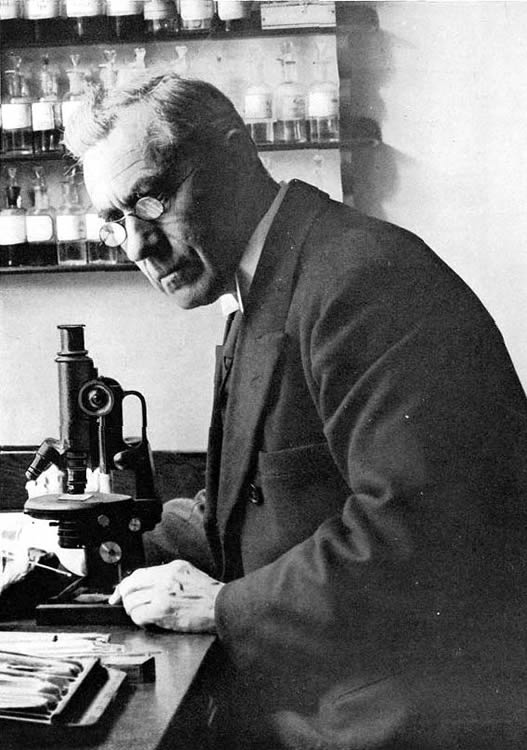
Celebrate Your Inner Virus
Abstract
Viruses are amazingly complex and beautiful machines. They exhibit all the hallmarks of being designed, though we often fail to recognize them as such. Therefore, we seek to highlight the strengths of what makes a virus on this Virus Appreciation Day.1 The design in viruses is highlighted in many different ways, from being essential during normal developmental processes to being used as novel therapy for treating brain cancer. It is important that we understand the design present in viruses because God made them. All creatures of our God demonstrate his handiwork, and viruses are no different.
At-a-Glance
- Viruses should be celebrated on Virus Appreciation Day because they are designed machines.
- In today’s fallen world, there are good aspects to viruses that are worth highlighting.
- Even though we live in a fallen world and most viruses are bad, God has allowed us to see the intricate design present in viruses.
October 3 is always Virus Appreciation Day. You might think that viruses are not worth celebrating; I disagree. We must realize that God designed everything—including viruses.2 The origin of Virus Appreciation Day remains unclear, with no real significance attached to the date of the celebration. (The only thing I have determined is that Virus Appreciation Day falls on 10-3 every year, a number which approaches the same size as other microbes like bacteria (10-3 m = 1 mm).3
Though the amazing design of viruses is often overlooked and deserves more attention than one day per year, viruses are celebrated by the fact that nearly all Nobel prizes in physiology and medicine can be traced back to a trait originally described in a virus. As I’ve heard, “Everything that I ever learned about molecular biology, I could have learned from [viruses].”4
Amazing Shapes and Sizes of Viruses
Viruses come in a variety of shapes and sizes. They are even somewhat classified based on their shape—simple, helical, or complex. The simple viruses have relatively straightforward shapes like a cylinder or sphere.5 While their name suggests that their shape is simple, the viruses are anything but simple in their design (more on their design below). The simple viruses include the first virus discovered: tobacco mosaic virus. Helical viruses are found in a helical shape and include viruses like Ebola. The complex viruses, such as the myovirus bacteriophage, are my personal favorite because they often look like spaceships.6

Tobacco Mosaic Virus. Image by Durova, via Wikimedia Commons.

Ebola Virus. Image by Masur, via Wikimedia Commons.

Artistic rendering of a T4 bacteriophage. Image by Adenosine, via Wikimedia Commons.
Viruses were originally identified because of their small particulate size. Martinus Beijerinck observed that, after filtering out extract from the leaves of tobacco plants infected with tobacco mosaic virus (TMV), its filtrate was still infectious.7 Therefore, he proved that the infectious material for the tobacco plant was smaller than the pore size of the filter that he used. The size of the virus that Beijerinck isolated was 250 nm by 18 nm, the smallest virus on record.8 On the opposite side of the virus spectrum is the largest virus, the Pithovirus sibericum, whose size generates a certain amount of controversy. The Pithovirus sibericum can be up to ~1.5 μm across, which is the size of some cells.9 Because it is so large, some originally misidentified this virus as actually being a cell. However, since its original discovery, Pithovirus sibericum has been classified as a virus.10

Martinus Willem Beijerinck. Image by Mdd, via Wikimedia Commons.
Virus Molecular Biology
Viruses are made up of protein and nucleic acid. The protein coat on a virus is referred to as its capsomere, a repeating unit that surrounds the nucleic acid on the inside. The protein coat capsomeres come together to form multiple capsomeres linked together in what is called the capsid. On the inside of the capsid is the nucleic acid, which is either DNA or RNA. The DNA or RNA on the inside of the capsid can exist sometimes as single-stranded or double-stranded. If the virus is an RNA virus, there is also the possibility that the virus genome is either plus-sense or minus-sense. The plus-sense or minus-sense to the genome indicates whether the RNA genome can immediately turn into a protein (plus-sense) or whether it serves as a template for further RNA production (minus-sense). After a virus enters the cell, it is important for the virus to begin making its proteins. Viruses make their proteins one of two ways: either as separate proteins or as a single polyprotein that is cleaved post-translationally.11 All viruses begin making their protein(s) after entering the cell while a certain class of RNA viruses, called retroviruses, turns their RNA genome into DNA before they begin making protein.
Intelligent Design of Viruses
Viruses are obligate intracellular parasites, which means that they only carry the minimal essential components for making more productive virus particles. When considering just how efficient viruses are at making more viruses, one cannot exclude the idea of referring to viruses as machines. A virus acts like a machine because it exhibits all the hallmarks of irreducible complexity. Irreducible complexity is the idea that a system ceases to function effectively when just one part of the system is removed. Viruses travel light and only carry just what they need for a productive virus infection. So if you take away any one part of what a virus carries with it, you will no longer produce the virus. If no virus is produced, then there is no effective infection. Therefore, viruses are irreducibly complex.
No modern virologist can honestly look at a virus and dismiss that they are irreducibly complex.
It is important to state that viruses are irreducibly complex because that means that they are designed. No modern virologist can honestly look at a virus and dismiss that they are irreducibly complex. The design inference for viruses is something that most scientists and lay people do not readily want to admit because of the “bad rap” that viruses get. However, if we understand that everything (including viruses) was originally created very good (Genesis 1:31), then we can appreciate that these viruses are the handiwork of God and point to his genius. With the Fall, we know that viruses now overwhelmingly cause negative effects in this fallen world, and we face death, disease, pain, and suffering from viruses. But it is important to realize the origin of viruses as well as their original good functions. While we live in this current fallen state, there are still many good things that viruses accomplish.12
Many viruses are related to what are called endogenous retroviruses.13 An endogenous retrovirus (ERV) is a piece of DNA found in an organism’s genome; it has several important functions. ERVs are related to viruses because they have signature genes contained within them at their ends that make them look like a retrovirus. A retrovirus is a special kind of virus that makes DNA from RNA and inserts into the genome of the host, so ERVs are actually very similar to a virus that is no longer moving around from host to host.
ERVs have a number of documented benefits to the host, including (but not limited to) mammalian development and host immune defenses (see the list below). ERVs were probably what God created originally to provide for the good things in our genome, but the curse may have caused some ERVs to exit the genome and become active outside of cells.14 However, ERVs are not the only probable source of modern day viruses since there is strong evidence that the Ebola genome is found in the genomes of wombats and guinea pigs.15 It is significant for Ebola to be found in a genome without causing disease because Ebola is an RNA genome that never exists as a DNA intermediate—therefore it is not a retrovirus. As such, some virus genomes (e.g., Ebola) are found within the genome of organisms and in a dormant state. Ultimately, it would be great to have an explanation for the original location within a host genome for every virus like retroviruses or Ebola, but the truth is that we cannot know the original genomic location for every viral genome.16 While we cannot know the ultimate location for every viral genome within some host genome, it is important to point out that evolutionists can’t account for their origin anywhere. When I was an undergraduate student, I asked my virology professor about which came first—the cell or the virus. His answer has stuck with me over the years because he was honest in telling me that virologists don’t have a clue to their origin. Whenever scientists are honest enough to tell the truth about origins, we usually end up with explanations like these, because we all know that viruses are efficient machines.
Viruses Are Molecular Machines
The machine analogy with viruses is a particularly strong one. If you remove any part of the virus, the virus effectively ceases to function. Furthermore, there is a strong emphasis on the idea that viruses are extremely efficient at what they do. They do not carry more than what is necessary to invade the host. Viruses are streamlined to carry only what they need and nothing more. They will often carry so little that they require some essential elements from the cells they’re infecting in order for them to “survive.”17 Since they are molecular machines, they have obvious design features as already stated. But it is important to realize that they are not designed to kill things all day long. If we didn’t have Scripture to guide us, then the only conclusion we could make about viruses is that they are designed to cause death, disease, pain, and suffering, because viruses are elegant machines that can accomplish that. However, we have Scripture, so we can know that God didn’t create viruses to kill us like some cosmic killjoy. What most people are surprised to learn is that God created viruses as part of his original, perfect creation. Even more surprising is that we can still see the good effects of viruses to this day, despite over 6,000 years of sin’s Curse.
A Short List of Good Viruses
- Perhaps the most straightforward example of beneficial viruses is the example of the ERV within our genome that encodes for the gene syncitin.18 The gene syncitin is required by all mammals to develop normally, because it is the gene that forms the syncytia from the developing embryo into the wall of the uterine lining. Without the syncitin gene, normal development does not occur, and there would be no life for any mammal. The virus encodes for an essential gene.
- One of my favorite examples of a beneficial virus is the example of a bacteriophage called APSE.19 APSE is a specific virus that infects bacteria. In particular, it infects the bacteria that live inside the cells of an aphid. The virus is beneficial because parasitoid wasps often attack aphids and lays their eggs inside the aphid. When the virus infects the bacteria inside the aphid cells, the parasitoid wasp is unable to lay its eggs and the aphid survives the attack. The virus saves the aphid from the wasp.
- Another example of a beneficial virus involves use of the Zika virus.20 While Zika normally causes viral microcephaly, scientists have recently found a good use for it in treating brain cancer victims.21 Since the virus targets brain cells and causes them to shrink, Zika virus has been used to treat patients with abnormally growing brain tumors; so far, researchers are seeing good results. This is an example of a normally harmful virus being used to treat another disease that is otherwise deadly.
- The norovirus is usually very harmful in humans and causes gastroenteritis. However in mice, the norovirus appears to be important in the normal development and protection of the murine immune system.22 This is a clear example of how a negative effect in one organism can be beneficial in another organism. Specifically, the norovirus helps the murine immune system rather than attack it.
- Another group of bacteriophages have been isolated and harnessed because of their ability to infect a specific bacterium called Listeria monocytogenes.23 These bacteriophages are marketed as the product ListShield and are beneficial for killing off the pathogen L. monocytogenes. L. monocytogenes is a foodborne pathogen that causes gastroenteritis and can lead to spontaneous abortions. So ListShield is used to kill off a dangerous pathogen as a therapy.
- Finally, whenever there are discussions about gene therapy in the news, it is almost always accomplished via viruses.24 Healthy genes are typically delivered to diseased people by using a virus (like adenovirus) and emptying the virus of its own genetic information to deliver the healthy gene to the patient. The empty virus simply gives the healthy gene to the patient and replaces the disease gene with the healthy gene. As a result, people are cured from a particular genetic ailment because of a virus.
We know that we live in a fallen world, but living in a fallen world does not mean that the fallen creation loses the complexity or beauty that its Creator originally intended.
The full list of significantly beneficial effects of viruses was highlighted in an important scientific review article, written by (as far as anyone can tell) an evolutionary virologist.25 More often than not, viruses are only considered bad because they cause so much death, disease, pain, and suffering, so we fail to recognize the intricate complexity and beauty of what God made. We know that we live in a fallen world, but living in a fallen world does not mean that the fallen creation loses the complexity or beauty that its Creator originally intended. The complexity and beauty of viruses is not lost completely in this fallen world and are something worth pausing to consider precisely because God created them. If we fail to recognize that viruses are designed, but affected by a fallen world, then we give up their wonderful design and begin to think that God is disinterested in the affairs of humanity or that God is some kind of cosmic monster. To the contrary, God has not just allowed us to see the complexity and design of viruses, but he has (in his infinite knowledge) also given us the tools to fight viruses in this fallen world. Not only has God given us these tools for fighting disease, he has also revealed himself as a God of love who sent his only begotten Son to redeem humanity (John 3:16). To properly communicate the gospel, we must recognize the true origin of viruses in light of their beneficial functions in today’s fallen world. We should not be surprised when we find good purposes for viruses because God created them in the first place. We should actually look for those good purposes and celebrate them—at least once a year.
Footnotes
- Holiday Insights, “Virus Appreciation Day,” http://www.holidayinsights.com/moreholidays/October/virusappreciation.htm.
- Genesis 1:31 very clearly teaches that everything was made within the time span of six days. “Everything” means that God must have created viruses. If God created viruses within the first six days of creation, they must have been described as “very good” as recorded in Genesis 1:31.
- Technically, the average bacteria size like E. coli is significantly smaller than 1 mm. The size of E. coli is 1 μm by 3 μm, which is 1,000 times smaller than 1 mm. So it remains a mystery why Virus Appreciation Day is celebrated on 10-3.
- My biochemistry professor in graduate school said this. In the context of his original quote, he actually said that he could’ve learned everything from lambda phage. Phage is short for bacteriophage, which are viruses that infect bacteria. The specific phage called lambda is a famous virus studied by everyone taking molecular biology.
- The actual shape of a spherical virus is an icosahedron, which is a 20-sided polygon. For more information on these shapes in general, read Encyclopaedia Britannica, s.v. “virus,” https://www.britannica.com/science/virus/Size-and-shape.
- In fact, there was a picture of a bacteriophage as a spaceship in the children’s television show Miles from Tomorrowland.
- Encyclopaedia Britannica, s.v. “Martinus W. Beijerinck, https://www.britannica.com/biography/Martinus-W-Beijerinck.
- G. J. Tortora, B. R. Funke, and C. L. Case. Microbiology: An Introduction. 12th ed. New York, NY: Pearson, 2016.
- D. G. Anderson, S. Salm, and D. Allen. Nester’s Microbiology: A Human Perspective. 8th ed. New York, NY: McGraw-Hill, 2015.
- M. Legendre et al., “Thirty-Thousand-Year-Old Distant Relative of Giant Icosahedral DNA Viruses with a Pandoravirus Morphology,” PNAS 111, no. 11 (March 3, 2014): 4274–4279, doi:10.1073/pnas.1320670111.
- Proteins are traditionally made by one gene encoding for one protein. However, not all viruses follow these rules. Some viruses make one really large protein from their genome that has multiple proteins contained within it. As such, it is called a polyprotein because there are multiple proteins made from one larger one. The polyprotein is cleaved post-translationally to make the individual proteins needed for virus replication.
- The intelligent design of viruses presents special problems for the intelligent design movement because the intelligent design movement does not acknowledge God as Creator. If the intelligent design movement would just acknowledge that God is Creator, they would not have problems with viruses. As it stands, viruses remain intelligently designed, and that means that the intelligent design movement would suggest that the designer created viruses to kill us. Obviously, this is a problem from a teleological point of view.
- For further reading about ERVs, read my article, “Do Endogenous Retroviruses (ERVs) Support Common Ancestry?”
- Not all ERVs have turned into viruses that exist outside our cells. We still have ERVs in our genome that do not cause harm. The title of this article reflects the fact that the ERVs we still have perform special functions that we often don’t understand.
- For further reading about Ebola, read my article, “Where Did Ebola Come From?”
- What we do know about viruses’ location originally is that they must have existed in a good state originally. Some of them may have existed as ERVs while some could have existed already on their own. What we know to be true is what Scripture plainly states about the Fall—that at the Fall, all of creation was cursed and we have thorns and thistles as a result. I often prefer thinking of viruses as molecular thorns and thistles because they do so much harm. Acknowledging that, the point of this article is to look at the positive aspects of viruses.
- Scientists debate about whether to consider viruses as being alive or not alive in the biological sense. On the whole, I like to consider viruses being alive in the biological sense.
- Carl Zimmer, “Mammals Made by Viruses,” The Loom, February 14, 2012, http://blogs.discovermagazine.com/loom/2012/02/14/mammals-made-by-viruses/.
- Mari. N. Jensen, “Aphids Saved From Gruesome Death by Virus-Infected Bacteria,” UANews, Aug. 21, 2009, https://uanews.arizona.edu/story/aphids-saved-from-gruesome-death-by-virus-infected-bacteria.
- For more information on the Zika virus, see my article “Zika Virus, the Olympics, and Genesis.”
- Mallory Locklear, “Scientists Could Use Zika to Fight Brain Cancer in the Future,” Yahoo, September 5, 2017, https://finance.yahoo.com/news/scientists-could-zika-fight-brain-212200784.html.
- “Viruses: You’ve Heard the Bad. Here’s the Good,” American Society for Microbiology, April 30, 2015, https://www.asm.org/index.php/asm-newsroom2/press-releases/93495-viruses-you-ve-heard-the-bad-here-s-the-good.
- Bacteriophages are specific to their host that they are capable of infecting. This particular bacteriophage is capable of infecting Listeria mononcytogenes only. Other researchers are looking to employ a similar approach in treating other bacterial infections as has already been done with L. monocytogenes treatment.
- “How Does Gene Therapy Work?,” Genetics Home Reference, https://ghr.nlm.nih.gov/primer/therapy/procedures.
- Marilyn J. Roossinck, “Move over Bacteria! Viruses Make Their Mark as Mutualistic Microbial Symbionts,” Journal of Virology 89 no. 13 (July 2015): 6532–6535, doi:10.1128/JVI.02974-14.
Recommended Resources

Answers in Genesis is an apologetics ministry, dedicated to helping Christians defend their faith and proclaim the good news of Jesus Christ.
- Customer Service 800.778.3390
- © 2024 Answers in Genesis


